Last Updated on January 5, 2023 by a Friendly Gardener
Peace lilies are favorites when it comes to houseplants. They are easy to take care of, adapt to low light conditions, and add a touch of elegance to your indoor décor. Beautiful blossoms will eventually pass, and foliage will die, so should you prune your Peace Lily houseplant, and how?
What Is Pruning?
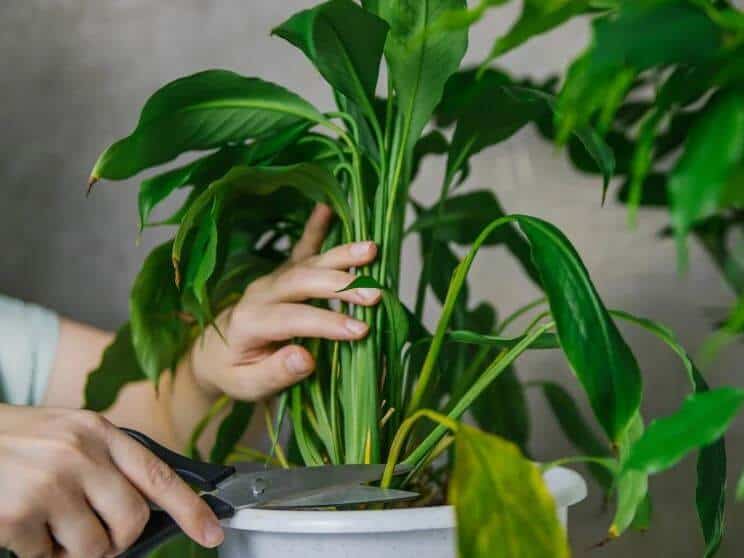
Pruning is the plant care term for trimming material from a plant. It is a common and necessary process that when performed correctly is beneficial to plants whether for indoor gardening or outdoor landscaping. Your Peace Lily plant will also benefit from pruning.
Yellow, brown, dried, or drooping foliage should all be removed. This not only contributes to a plant’s appearance but will prevent infections or diseases from spreading through a plant. Trimming also aids with pest infestation and control.
One incredible benefit of pruning is to aid a plant in directing its energy to healthy plant parts. By pruning your plant will not waste energy on stalks or foliage that is destined to pass anyway. Pruning is also a method for harvesting material for the propagation of many plants. Although a need for pruning is primarily inspired by aesthetic reasons, it is an essential tool in managing energy, discouraging infection and disease, and improving air circulation.
Peace Lily Growth
Spathiphyllum is the Peace Lily’s botanical name. It belongs to the Araceae family. This is not a rapidly growing plant nonetheless will reach its maturity sometime between the third and fifth year of growth.
The Peace Lily can grow from a minimum of six inches to a foot annually for its first three years of life, and this growth will be not only in height but in width as well. Most indoor Peace Lily houseplants will end growth gain at two to three feet in size. These houseplants reach maturity within the first several years of growth if they are fed regularly during their growing season.
The Peace Lily can be kept to a smaller size through plant division or pruning.
Should I Prune My Peace Lily?
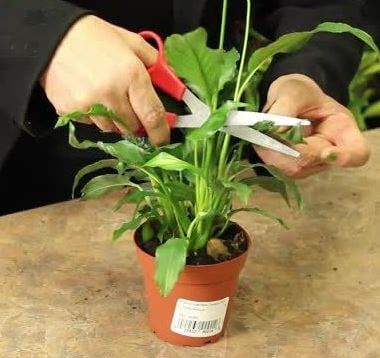
Beloved for their beautiful white bracts that we consider to blossom, these bracts are truly a white leaf that has modified itself. The white leaf envelops a cluster of minuscule blossoms growing on a stalk. Eventually, these flowers will pass, turn green, and the bract will droop. So, yes when your bract is spent it’s time to prune and pruning is not limited to the white bracts alone.
How to Prune Peace Lily Leaves
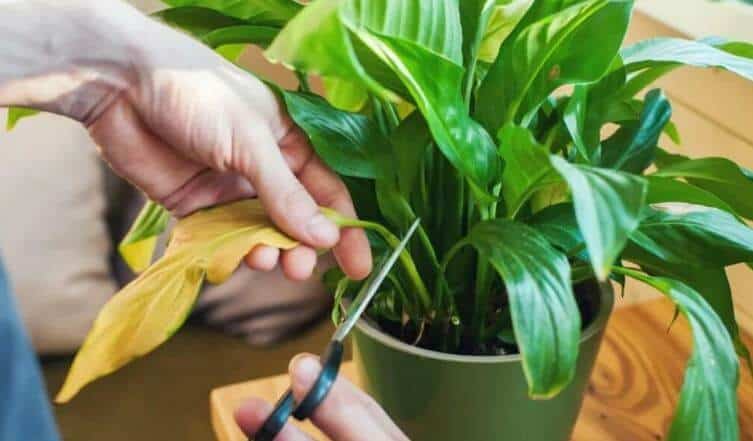
Deadheading is the method used to improve a plant’s appearance when blooms are spent and need to be removed. When Peace Lilies bloom, the individual stalks will produce only a single flower, so once they are spent, they should be removed as no other bracts will appear. The stalk will also pass and turn brown as well, so the entire stalk should be removed. Remove the stalk at the plant’s base, as this stimulates new growth.
Pruning Peace Lily foliage isn’t limited to stalks with spent bracts. Leaves may turn yellow and begin to shrivel. This is generally the result of too little watering or too much light exposition, but it can also be due to age. If the plant’s foliage is drying out or changing color for some reason, these leaves will need to be removed and they should be snipped at the base of the leaf stalk.
Also, consider removing thin weak leaves as well as foliage that is contributing to overcrowding. You don’t want leaves that are unable to unfurl. Unfurled foliage can trap debris and excess moisture leading to infection.
When to Prune Peace Lily
Most plants need to be pruned when they enter dormancy. Not so for your Peace Lily! It’s recommended that pruning be avoided during their rest period in the fall and in the winter.
Ideally, it’s best to prune peace lilies during their growing season in spring and summer till the beginning of autumn as this species needs to replace foliage quickly. The exception to this will be dying or dead leaves which should be removed regardless of the season.
Pruning should be avoided if the plant has been recently repotted to avoid adding to the trauma.
Pruning Peace Lily Considerations
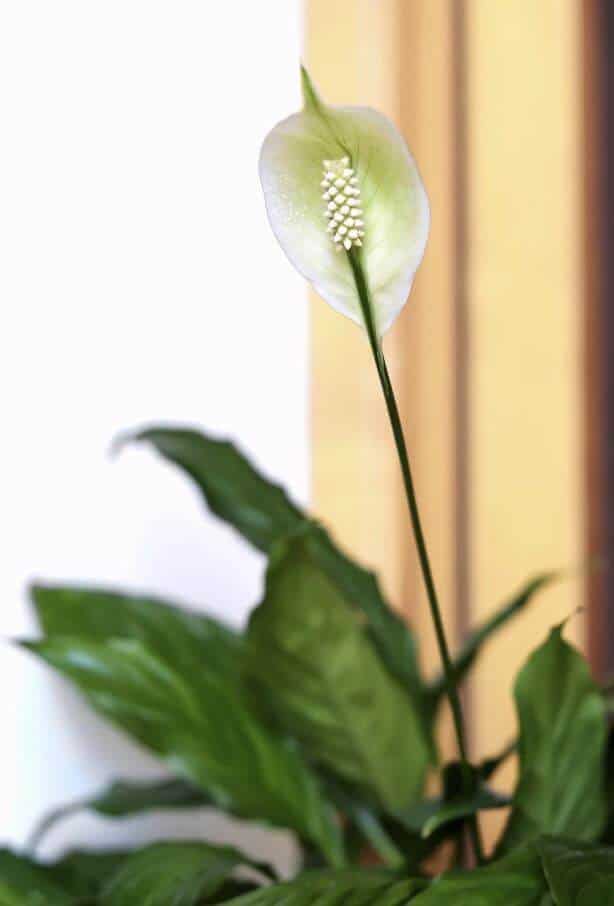
Pruning your Peace Lily will be relatively easy as single leaves grow on individual stems. Pruning scissors will offer better control when trimming but any pair of sterile sharp scissors will work.
Only snip off the individual stem you want to prune, so take care not to snip more than one stalk at a time. In some instances, you may be able to pinch stalks, but sharp clean scissors are a better choice. As a slightly toxic plant, gloves are recommended when pruning.
Damaged, dried, or dying Peace Lily foliage should be removed whenever they appear.
Shaping a Peace Lily Plant
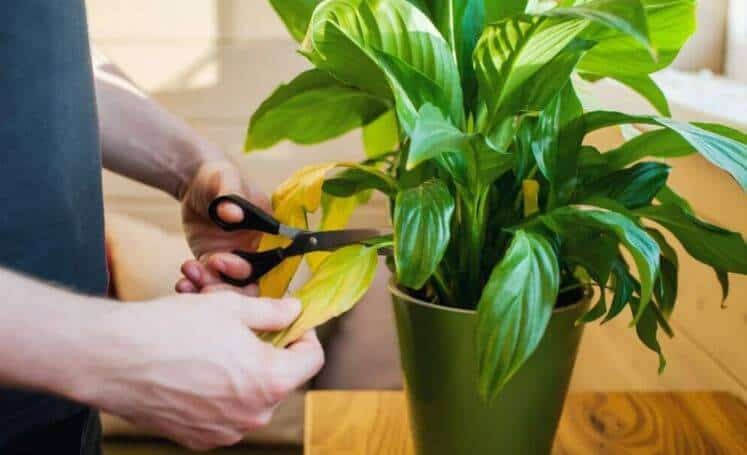
While the Peace Lily is not a plant that requires much shaping, it can be done. You may consider trimming at the plant’s center to encourage air circulation, or around the edges for a tidier appearance.
For a plant that has an upright appearance, trim around the plant’s outer perimeter. If you prefer a smaller Peace Lily, you may want to opt for a division to create several smaller and more manageable plants.
Pruning to shape your plant should take place annually during the plant’s growing season. Plan on feeding your plant approximately a month before shaping to support recovery.
If you choose to prune your plant to shape it, never prune more than ten percent of your Peace Lily’s foliage at the same time except for damaged or dying leaves, and never prune more than once or twice annually during the peak growing season.
Wait several days before watering after trimming and wait a month before resuming feeding your plant.
Pruning is not usually a cause of shock or trauma, but division can trigger this reaction. If you have used division or pruned significantly, avoid changes in environmental temperature and opt for a lower light location to aid your plant in recovery.

